
Mammals
This is probably the most admired and loved family of animals and contains many of our favourite species, including:
Primates
Monkeys and Apes are our closest relatives. The easy way to tell them apart is that monkeys have tails (with some exceptions) Some South American (aka New World) Monkeys like our resident Howler Monkeys use their prehensile tails as a fifth limb for climbing and balancing.
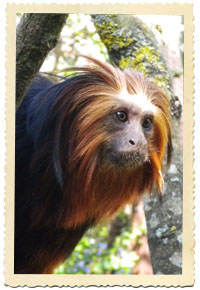 Increasing in size from Marmosets and Tamarins, you can meet our Squirrel Monkeys and finally the largest and loudest monkey at Amazon World, the Black Howler Monkey.
Increasing in size from Marmosets and Tamarins, you can meet our Squirrel Monkeys and finally the largest and loudest monkey at Amazon World, the Black Howler Monkey.
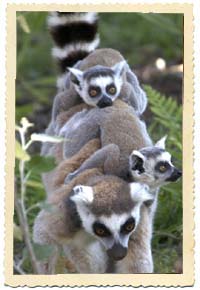 Lemurs are closely related to Primates and are only found on the island of Madagascar off the coast of Africa. All are endangered due to habitat destruction and we at Amazon World have three species: the Ring-tailed Lemurs from the grassland areas of Madagascar and the closely related Red Ruffed and Black and White Ruffed Lemurs from the Rainforest areas..
Lemurs are closely related to Primates and are only found on the island of Madagascar off the coast of Africa. All are endangered due to habitat destruction and we at Amazon World have three species: the Ring-tailed Lemurs from the grassland areas of Madagascar and the closely related Red Ruffed and Black and White Ruffed Lemurs from the Rainforest areas..
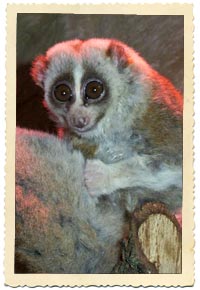 The Loris family are distant relations of the Primates. These shy nocturnal creatures from Asia spend much of the day curled up motionless in the crook of a tree and when they do become active after dark they hunt insects and search for fruit by slowly creeping along branches. We house both our Slow Loris and Pygmy Slow Loris in 'Reverse lighting enclosures' this means that their night time is actually our day time! As well as enabling us to see them at their most active it allows us to more easily monitor their health and behaviour.
The Loris family are distant relations of the Primates. These shy nocturnal creatures from Asia spend much of the day curled up motionless in the crook of a tree and when they do become active after dark they hunt insects and search for fruit by slowly creeping along branches. We house both our Slow Loris and Pygmy Slow Loris in 'Reverse lighting enclosures' this means that their night time is actually our day time! As well as enabling us to see them at their most active it allows us to more easily monitor their health and behaviour.
Rodents
Approximately half of all species of mammal are rodents! Although they are a very successful group of animals they are often killed and eaten by many other animals for food. The largest, the Capybara, is equally at home either in or out of the water, they have webbed feet to aid 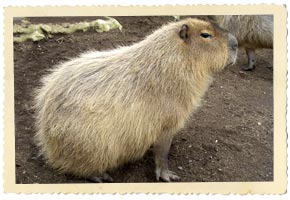 swimming and at any hint of danger dive into and under the surface of even the fastest flowing river! Mara (or Patagonian Hare) have very long, powerful back legs to allow them to sprint away from danger and Porcupines have found safety in special hairs that grow into spikes forming a defensive coat that keeps even the most determined predator away!
swimming and at any hint of danger dive into and under the surface of even the fastest flowing river! Mara (or Patagonian Hare) have very long, powerful back legs to allow them to sprint away from danger and Porcupines have found safety in special hairs that grow into spikes forming a defensive coat that keeps even the most determined predator away!
Cats
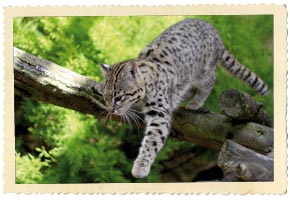 Habitat destruction is only one of the reasons animals become endangered. Hunting for food and fur takes a huge toll on populations and cats, with their beautifully marked coats, are highly sort after even today! Both the Ocelot and Geoffroy's Cat have been persecuted for many years and even as recently as the 1980's, an estimated 50,000 Geoffroy's Cats and 200,000 Ocelot were killed each year for their skins.
Habitat destruction is only one of the reasons animals become endangered. Hunting for food and fur takes a huge toll on populations and cats, with their beautifully marked coats, are highly sort after even today! Both the Ocelot and Geoffroy's Cat have been persecuted for many years and even as recently as the 1980's, an estimated 50,000 Geoffroy's Cats and 200,000 Ocelot were killed each year for their skins.
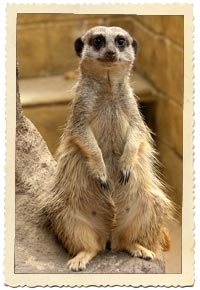 Although Cats normally live a solitary life, some other animals find that living together is better. Meerkats live in large family groups and as well as being safer from predators (with their famous sentries) they also give each other help with other duties like searching for food and babysitting.
Although Cats normally live a solitary life, some other animals find that living together is better. Meerkats live in large family groups and as well as being safer from predators (with their famous sentries) they also give each other help with other duties like searching for food and babysitting.
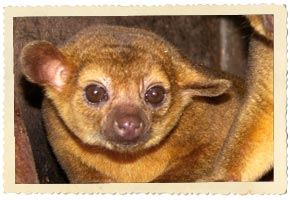
How can we describe a Kinkajou? Well it's related to the Raccoon family, it's about the size of a domestic cat but has a very long 'Prehensile' tail. It eats fruit, small animals and insects and loves breaking into beehives and stealing the honey! In South America it is known as the 'Honey Bear'
Tapir & Peccaries
Some of the larger animals found in the rainforest are some of the most secretive.The Tapir uses its trunk-like nose as a snorkel so that it can hide underwater when in danger. Peccaries are wild hairy pigs that live in the thick jungle undergrowth. They are very intelligent and shy but wait until they yawn and show off their huge tusks! If threatened they are well able to defend themselves!
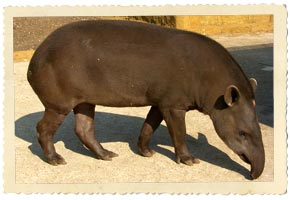
Rare & Unusual
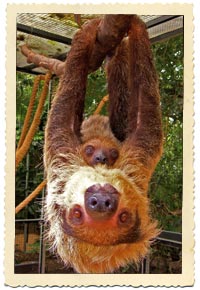 Sloths are quite large fruit and leaf eating mammals. They sleep for up to 18 hours a day and rarely come down out of the trees. They are very difficult to breed and there had been no births in the UK for 55 years until March 2000 when we found we had a new arrival! Another baby was born in September 2001 and we have just found suitable mates for both our now fully-grown babies.
Sloths are quite large fruit and leaf eating mammals. They sleep for up to 18 hours a day and rarely come down out of the trees. They are very difficult to breed and there had been no births in the UK for 55 years until March 2000 when we found we had a new arrival! Another baby was born in September 2001 and we have just found suitable mates for both our now fully-grown babies.
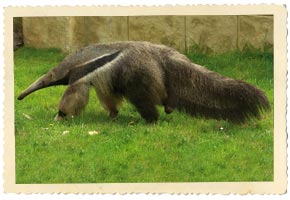
Anteaters are another unusual speciality at Amazon World. The Tamandua is a South American anteater that lives in the Rainforests. It is a very good climber and has verypowerful front claws that it uses to rip open the hard outer walls of ant and termite nests. They, like the sloth, are difficult to breed and because of their very special diet (no we don't have to go out collecting ants!) have not been kept in captivity in any great numbers. As all the anteater species have become more and more endangered in recentyears, we embarked on a project to learn about and breed this fascinating animal. The results of this project have been fantastic! We now have 6 individuals from two different sub-species and were the first Zoo in the UK ever to breed them, which we have now done twice!
 Animal Adoption
Animal Adoption
Find out about how you can help protect endangered species through our animal adoption program here at Amazon World Zoo Park. Read more...


